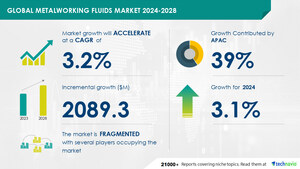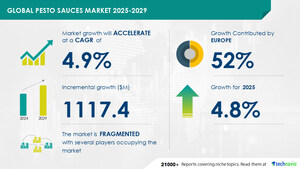NEW YORK, Oct. 14, 2024 /PRNewswire/ -- Report with market evolution powered by AI- The global internet of things enabled industrial wearables market size is estimated to grow by USD 20563.1 mn from 2024-2028, according to Technavio. The market is estimated to grow at a CAGR of almost 57.2% during the forecast period. Rise in digitalization and automation within industries is driving market growth, with a trend towards rising focus on increasing battery life. However, high cost of wearable devices and technology poses a challenge. Key market players include ASUSTeK Computer Inc., EUROTECH Spa, Fujitsu General Ltd., Generalscan, Hitachi Ltd., Honeywell International Inc., Intellinium, Iristick NV, Magic Leap Inc., Microsoft Corp., Optinvent, RealWear Inc., Samsung Electronics Co. Ltd., SAP SE, Seiko Epson Corp., ThirdEye Gen Inc., Vuzix Corp., WESTUNITIS Co. Ltd., Workaround GmbH, and WORKERBASE GmbH.
Key insights into market evolution with AI-powered analysis. Explore trends, segmentation, and growth drivers- View the snapshot of this report
Internet Of Things Enabled Industrial Wearables Market Scope |
|
Report Coverage |
Details |
Base year |
2023 |
Historic period |
2018 - 2022 |
Forecast period |
2024-2028 |
Growth momentum & CAGR |
Accelerate at a CAGR of 57.2% |
Market growth 2024-2028 |
USD 20563.1 million |
Market structure |
Fragmented |
YoY growth 2022-2023 (%) |
39.6 |
Regional analysis |
North America, Europe, APAC, South America, and Middle East and Africa |
Performing market contribution |
North America at 42% |
Key countries |
US, China, Germany, UK, and Japan |
Key companies profiled |
ASUSTeK Computer Inc., EUROTECH Spa, Fujitsu General Ltd., Generalscan, Hitachi Ltd., Honeywell International Inc., Intellinium, Iristick NV, Magic Leap Inc., Microsoft Corp., Optinvent, RealWear Inc., Samsung Electronics Co. Ltd., SAP SE, Seiko Epson Corp., ThirdEye Gen Inc., Vuzix Corp., WESTUNITIS Co. Ltd., Workaround GmbH, and WORKERBASE GmbH |
Market Driver
In the IoT enabled industrial wearables market, battery life has emerged as a significant challenge. The integration of heavy equipment in wearables reduces battery quality due to the considerable space batteries occupy. This issue is particularly pressing in industries that collect large amounts of data and require extended operating periods. To address this concern, vendors are focusing on low-power consumption technologies like Bluetooth 5.0 and innovative system-level and circuit-level designs to minimize power consumption. Additionally, some vendors are developing battery-free IoT wearables, such as those using flexible, printable batteries. For instance, researchers at the University of Manchester have created textile-based batteries using a simple screen-printing technique. Advancements in power harvesting technologies are also helping to resolve battery limitations in resource-intensive sectors like mining and petroleum. These benefits are driving the adoption of IoT wearables across manufacturing industries, contributing to revenue growth in the global market.
The Industrial Wearables market is witnessing significant growth due to the integration of Internet of Things (IoT) technology. Key trends include battery life and power harvesting for extended usage, network connectivity for real-time data transfer, and high cost due to advanced sensors and technology. Staff shortages drive the need for these solutions, especially in industries like Healthcare, Construction, and Manufacturing, which are embracing Industry 4.0 and Predictive maintenance solutions. Wearables like smart glasses, helmets, and biometric sensors, including RFID tags, are transforming logistics and automation. Technology firms, wearable device manufacturers, and industrial solution providers collaborate to develop wireless communication protocols and cloud computing infrastructure for performance optimization. Biometric feedback devices, body-worn sensors, and smart eyewear are revolutionizing industries, with hand-worn wearables and portable wearables also gaining popularity. The Energy Industry is also adopting these technologies for monitoring and optimization. Cases and frames, connectivity components, touchpads and sensors, cameras, and Bluetooth 5 are essential components of these advanced wearables.
Request Sample of our comprehensive report now to stay ahead in the AI-driven market evolution!
Market Challenges
- The cost remains a significant barrier to the adoption of IoT-enabled industrial wearables due to their inherent complexity and the need for additional infrastructure. Industrial wearables are more complex than consumer devices, leading to higher costs for software development and networking solutions. Complexity accounts for 70-80% of the total production cost of industrial wearable software. Furthermore, the use of advanced technologies like AR or VR adds to the expense. While consumer wearable prices have decreased, the high cost of IoT industrial wearables may limit their adoption among budget-conscious end-users throughout the forecast period.
- The Industrial Wearables market, driven by IoT technology, is experiencing significant growth in industries like Healthcare, Construction, and Manufacturing. However, challenges persist. Battery life and power harvesting are key concerns, requiring advancements in technology. Network connectivity and high cost are also obstacles. Staff shortages push for solutions that are easy to use and maintain. Sensors, data analytics, and predictive maintenance solutions are essential. Logistics and healthcare industries benefit from biometric sensors and RFID tags. Technology firms, wearable device manufacturers, and industrial solution providers collaborate to address these challenges. Wireless communication protocols like Bluetooth 5 and cloud computing infrastructure optimize performance. Cases and frames, connectivity components, touchpads, sensors, cameras, and biometric feedback devices are crucial components. Hand-worn, head-mounted, and portable wearables, including smart glasses, helmets, and biometric sensors, are transforming industries through automation and digitization.
Discover how AI is revolutionizing market trends- Get your access now!
Segment Overview
This internet of things enabled industrial wearables market report extensively covers market segmentation by
- Product
- 1.1 Hand-worn wearables
- 1.2 Head-mounted wearables
- 1.3 Smart eyewear
- End-user
- 2.1 Automotive
- 2.2 Manufacturing
- 2.3 Aerospace
- 2.4 Others
- Geography
- 3.1 North America
- 3.2 Europe
- 3.3 APAC
- 3.4 South America
- 3.5 Middle East and Africa
1.1 Hand-worn wearables- The Internet of Things (IoT) enabled industrial wearables market is experiencing significant growth. Companies are integrating IoT technology into workwear to enhance productivity and safety. Wearables like smart helmets, gloves, and vests provide real-time data on worker health, equipment performance, and environmental conditions. This data enables predictive maintenance, improves efficiency, and ensures regulatory compliance. The market is expected to continue expanding as more industries adopt IoT technology.
Download a Sample of our comprehensive report today to discover how AI-driven innovations are reshaping competitive dynamics
Research Analysis
The Internet of Things (IoT) enabled industrial wearables market is experiencing significant growth due to the integration of advanced technology in traditional workwear. These wearables, including smart eyewear, head-mounted wearables, hand-worn wearables, and portable wearables, are revolutionizing industries such as the Medical, Manufacturing, Energy, and Construction sectors. Equipped with sensors, connectivity components, touchpads, and cameras, these wearables enable real-time data collection and analysis, enhancing productivity and safety. In the Medical Industry, IoT wearables are used for remote patient monitoring and telemedicine. In Manufacturing and Energy Industries, predictive maintenance solutions are employed for equipment monitoring and maintenance scheduling. Cases and frames protect these wearables from damage, while connectivity and data analytics enable seamless integration with industrial systems. The Logistics Industry benefits from real-time tracking and inventory management, while Healthcare professionals use these wearables for hands-free access to patient information. Industry 4.0's focus on smart factories and digital transformation is further fueling the demand for IoT industrial wearables. With continued innovation and technological advancements, the future of industrial wearables looks promising.
Market Research Overview
The Internet of Things (IoT) enabled Industrial Wearables market is experiencing significant growth due to the increasing demand for automation, digitization, and data analytics in various industries such as the Medical, Manufacturing, Energy, and Construction sectors. Industrial wearables include Smart Eyewear like smart glasses and helmets, Hand-worn Wearables, Portable Wearables, and Head-mounted Wearables. These devices incorporate advanced features like touchpads and sensors, camera, Bluetooth 5, and RFID tags. Industrial wearables are being adopted in the Medical Industry for remote patient monitoring, in the Manufacturing Industry for predictive maintenance solutions, and in the Energy Industry for monitoring and optimizing energy usage. Cases and frames, connectivity components, and battery life are critical factors influencing the market's growth. Power harvesting and network connectivity are essential for extending battery life and ensuring seamless communication. However, high costs, limited battery life, and staff shortages are challenges hindering the market's growth. Technology firms, wearable device manufacturers, and industrial solution providers are collaborating to develop advanced wearables with biometric feedback devices and body-worn sensors. Wireless communication protocols, cloud computing infrastructure, and performance optimization are essential for ensuring seamless data transfer and analysis. Industry 4.0 and the adoption of IoT technologies are driving the demand for industrial wearables in logistics, healthcare, and other industries. Predictive maintenance solutions, smart glasses, smart helmets, and biometric sensors are revolutionizing the way industries operate and are expected to continue driving the growth of the Industrial Wearables market.
Table of Contents:
1 Executive Summary
2 Market Landscape
3 Market Sizing
4 Historic Market Size
5 Five Forces Analysis
6 Market Segmentation
- Product
- Hand-worn Wearables
- Head-mounted Wearables
- Smart Eyewear
- End-user
- Automotive
- Manufacturing
- Aerospace
- Others
- Geography
- North America
- Europe
- APAC
- South America
- Middle East And Africa
7 Customer Landscape
8 Geographic Landscape
9 Drivers, Challenges, and Trends
10 Company Landscape
11 Company Analysis
12 Appendix
About Technavio
Technavio is a leading global technology research and advisory company. Their research and analysis focuses on emerging market trends and provides actionable insights to help businesses identify market opportunities and develop effective strategies to optimize their market positions.
With over 500 specialized analysts, Technavio's report library consists of more than 17,000 reports and counting, covering 800 technologies, spanning across 50 countries. Their client base consists of enterprises of all sizes, including more than 100 Fortune 500 companies. This growing client base relies on Technavio's comprehensive coverage, extensive research, and actionable market insights to identify opportunities in existing and potential markets and assess their competitive positions within changing market scenarios.
Contacts
Technavio Research
Jesse Maida
Media & Marketing Executive
US: +1 844 364 1100
UK: +44 203 893 3200
Email: [email protected]
Website: www.technavio.com/
SOURCE Technavio

WANT YOUR COMPANY'S NEWS FEATURED ON PRNEWSWIRE.COM?
Newsrooms &
Influencers
Digital Media
Outlets
Journalists
Opted In






Share this article